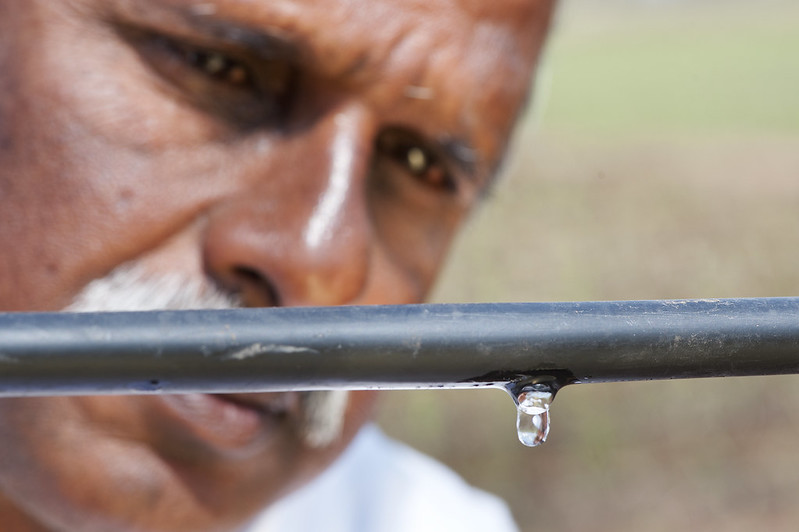With water sources dwindling and harsher climate conditions on the rise, farmers in the developing world need both better crop varieties and improved water management practices. This World Water Day, Gustavo Teixeira, EiB Module lead for Breeding Operations and Phenotyping, explores how crop breeding success is bound to water use.
The world relies on water for agriculture, energy and industry. And each human being needs water for sanitation, hygiene, food production – and mere survival. But our water sources are dwindling, water quality is being degraded, and water-related crises are escalating, intensified by climate unpredictability. This is all deepened by agricultural practices, which consume 70% of all water withdrawn from rivers, lakes and streams.
With food demand expected to double in low-income countries by 2050, agricultural water productivity and efficiency must be prioritized.
Given these challenges, crop breeding institutions targeting the developing world, such as CGIAR, have an enormous responsibility on their shoulders. Developing varieties aligned with farmers needs is the main goal for breeding programs. And this means meeting extreme conditions, such as drought.

Photo: by Hamish John Appleby for IWMI. A farmer checks the drip irrigation system system at his rice field in Govindapuram,Tamil Nadu, India.
But just as we develop varieties that meet farmers’ needs, we need to ensure the entire R&D process improves water sustainability. There are three ways crop breeders can manage water to deliver the best seeds and create the best conditions for long-term crop production:
1. Good agronomic practices must be part of the delivery:
The development of any technology should not be done in isolation; an integrated best practice package should be developed and adopted by breeders, and delivered to farmers. These include conservation agriculture practices such as zero tillage, which contribute to reducing evapotranspiration, consequently reducing the demand for irrigation water. These practices, as well as defining the breeding targets, need to be developed in partnership with extension programs to ensure local knowledge and support are ingrained.
A package that comprises better adapted crop varieties, improved agronomic practices, and use of inclusive business models for smallholder irrigation, such as solar pump technology, can advance both sustainability and incomes for small farmers. These practices have been found to improve water management and bring substantial increases in crop yields. And they hold the promise of being adoptable by resource-poor farmers.
But adoption will only be possible if strong coordination among different actors exists. This means engaging farmers, extension programs, businesses and NGOs. Breeders can take a leadership role, defining a long-term strategy, and engaging on the ground locally.
2. Breeders need the best protocols:
Developing varieties adapted to different drought conditions is the breeder’s prime contribution. Many cutting-edge tools and methods exist to ensure the best strategy to breed for drought. These include using marker-assisted selection (MAS), biotechnology, germplasm definition, introgression and phenotyping tools. However, site (or station) implementation and irrigation protocols must be applied first.
Defining the right location to establish a drought screening trial is imperative. Breeders need to clearly define the conditions under which crops will be grown – climate, soils, management practices etc. – called the target population environment (TPE). Appropriate breeding stations can then be selected, with irrigation and other strategies tailored to closely resemble the TPEs.
Understanding soil conditions, defining the irrigation parameters, and managing irrigation in breeding trials to simulate the desired stress will provide the necessary conditions to evaluate resulting varieties. But it is not uncommon to see breeding programs operating without clear protocols. Organizations need to invest in developing them and making them available to breeding programs in lower income countries – for example, CIMMYT’s protocols around drought stress. Defining protocols is a multidisciplinary effort that involves experts from physiology, engineering, agronomy and others. CGIAR Excellence in Breeding has been developing and collating these and other tools and making them available in a global toolbox, and working with programs to employ them.
3. Research stations must lead by example:
Breeders also need to focus on the water sustainability practices within their research stations. The ways in which a variety is developed will serve as an example to farmers in the region. To improve, it is important for breeders to work closely with operational team in different stages.
Firstly, at the irrigation system implementation stage, breeders must clearly define the requirements, such as field size, that are imperative for implementing a reliable and efficient system. Second, at the irrigation operation stage, they need to adopt the best technologies such as soil moisture probes and weather stations. And the data needs to be properly analyzed to provide accurate irrigation recommendations.
Crop breeding is already improving yields, delivering better food, and increasing smallholder incomes. But water challenges threaten to hold back these promising results. However, if breeders invest in partnering on conservation agriculture promotion, using the best protocols, and implementing best practices at their own research stations, we can create better seeds and a more productive water environment. Water management practices need to be integral to every step of the research phase.
-----
By Gustavo Teixeira, CGIAR Excellence in Breeding (EiB), Module lead: Breeding Operations and Phenotyping, with EiB Communications lead Adam Hunt.
This blog reflects the information and views of the authors only. EiB and partners are supported by CGIAR Trust Fund Contributors and the Crops to End Hunger initiative, via the Bill and Melinda Gates Foundation, GIZ, BMZ, USAID, UK Aid, ACIAR and other partners.